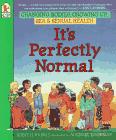 It's Perfectly Normal
It's Perfectly Normalby Robie H. Harris, Michael Emberley (Illustrator)
90 pages
Published by Candlewick Press, 1996 - ISBN: 1564021599
Teaching Your Kids About Sex:
Discussion Books
 It's Perfectly Normal
It's Perfectly Normal
by Robie H. Harris, Michael Emberley (Illustrator)
90 pages
Published by Candlewick Press, 1996 - ISBN: 1564021599
I hardly know where to start in praising this book! The writing is very frank, and may provide more than some parents wish their kids to know at this stage. The drawings are cartoonish, but still realistic enough to make sense and appeal to kids. Two friends, a bird and a bee, appear on every page to make comments on the text, and provide every reader with someone to identify with - the bird is excited about growing up, while the bee is embarrassed and not as interested. Boys and girls will appreciate knowing that they are learning the same stuff (there aren't two copies for either gender). Just about every topic is addressed, if briefly: reproduction, homosexuality, physiology, menstruation, erections and ejaculation, changes in body shape and smell, changes in emotions, masturbation, families and pregnancy, birth control/family planning, sexual abuse, STD's and AIDS - everything! The best part, though, is the two page spread of drawings of different types of naked bodies: fat, thin, tall, all colors, all ages, even people in wheelchairs. These two pages alone are worth the price of the book.
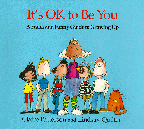 It's OK to Be You: A Frank and Funny Guide
to Growing Up
It's OK to Be You: A Frank and Funny Guide
to Growing Up
by Claire Patterson, Lindsay Quilter (Illustrator)
Ages 9-12, 70 pages
Published by Tricycle Press, 1994 - ISBN:1883672163
This book doesn't have as much factual information or cultural diversity as the previous one, but it is nearly as endearing simply because of its cast of characters. You are introduced to a funky-looking gang of seven friends at the beginning of the book, each with their own personality: the smart and sassy Grandma, the know-it-all Steve, Ice Cream (who's so worried about the size of his ears that he wears an ice cream cone on his nose to draw attention), even a girl named Horse who decides she's a... well, a horse. Instead of clinical information, the book focuses on feelings associated with growing up, and does so with a total lack of sentimentality that kids will appreciate. The information is presented in a conversational manner, and the comments of the characters are witty and will ring true for many kids entering puberty. Like "It's Perfectly Normal" (see above), the book is for both boys and girls. Together, they make a great set.
 Asking About Sex and Growing Up
Asking About Sex and Growing Up
by Joanna Cole, Alan Tiegreen (Illustrator)
Ages 9-12, 90 pages
Published by William Morrow & Co, 1988 - ISBN: 0688069282
This is a question-and-answer book which covers much of the same ground as the above books, and would be unexceptional if the questions weren't so good. The authors assume their readers know the basics about pregnancy and doesn't bother with much detail; it focuses instead on puberty in boys and girls, masturbation, having crushes, pregnancy, homosexuality, and one chapter entitled "The Most Important Thing to Know About Sex" (to respect yourself and others). There's an excellent chapter on teen pregnancy. This quiet, unassuming book with non-graphic pictures is an excellent choice for kids who don't ask many questions about sex.

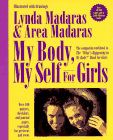 What's Happening to My Body? Book for
Girls/Boys
What's Happening to My Body? Book for
Girls/Boys
by Lynda Madaras
Ages 9-15, 304 pages
Published by Newmarket Press, 1987 - ISBN: 0937858986 (girls),
1557040028 (boys)
Although this book scrapes the upper age range of this review, I couldn't leave out Ms. Madaras's landmark work, now accompanied by a companion workbook; each is available for boys or girls. Includes description of puberty, including different shapes and sizes of breasts and bodies, menstruation, as well as topics for older kids like birth control, date rape and STD's. Somewhat lacking in discussion of masturbation. Like all the books mentioned here, it is intended for parents and their kids to share and discuss, so the fact that it is fairly long shouldn't be a deterrent.
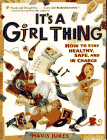 It's A Girl Thing: How To Stay Healthy,
Safe and In Charge
It's A Girl Thing: How To Stay Healthy,
Safe and In Charge
by Mavis Jukes, Debbie Tilley (Illustrator)
Ages 9-12, 135 pages
Published by Knopf, 1996 - ISBN: 0679873929
Newberry award-winning author Mavis Jukes writes an engaging book for preteen girls, explaining in detail everything that will be happening to the reader's body, emotions and social structure during puberty. Includes the important bits about sex, menstruation, birth control and STD's, but girls will find her stories about trying on bras and having your period away from home to be the most interesting part. Provides companionship, empowerment and appreciation for the feelings of preteen girls, which is what they need anyway. A good predecessor for "What's Happening to My Body?"
Changes in You and Me: A Book About
Puberty Mostly For Boys/Girls
by Paulette Bourgeois, Martin Wolfish, Kim Martyn
Ages 9-12, 64 pages
Published by Andrews & McMeel, 1994 - ISBN: 0836228146 (boys),
0836228154 (girls)
Similar to the Madaras books, with a copy each for girls and boys, but doesn't quite live up to the legacy. Includes transparent plastic overlays at several points to illustrate changes, but the overlays seem more like a gimmic than a useful tool. Generally good layout, with an attractive mix of pictures, text and interactive sections. Includes a small amount of information on STD's, AIDS and good/bad touching.
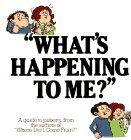 What's Happening To Me?
What's Happening To Me?
by Peter Mayle
188 pages
Published by Lyle Stuart, 1981 - ISBN: 0818403128
Written by the same person who wrote the bestselling "Where Did I Come From?" (see Picture Books), this book has fine content, but fails to appeal to its older target audience. At this point, most children have probably outgrown the laugh-out-loud-about-puberty stage, and would prefer a more earnest, straightforward tack. Try a different book.